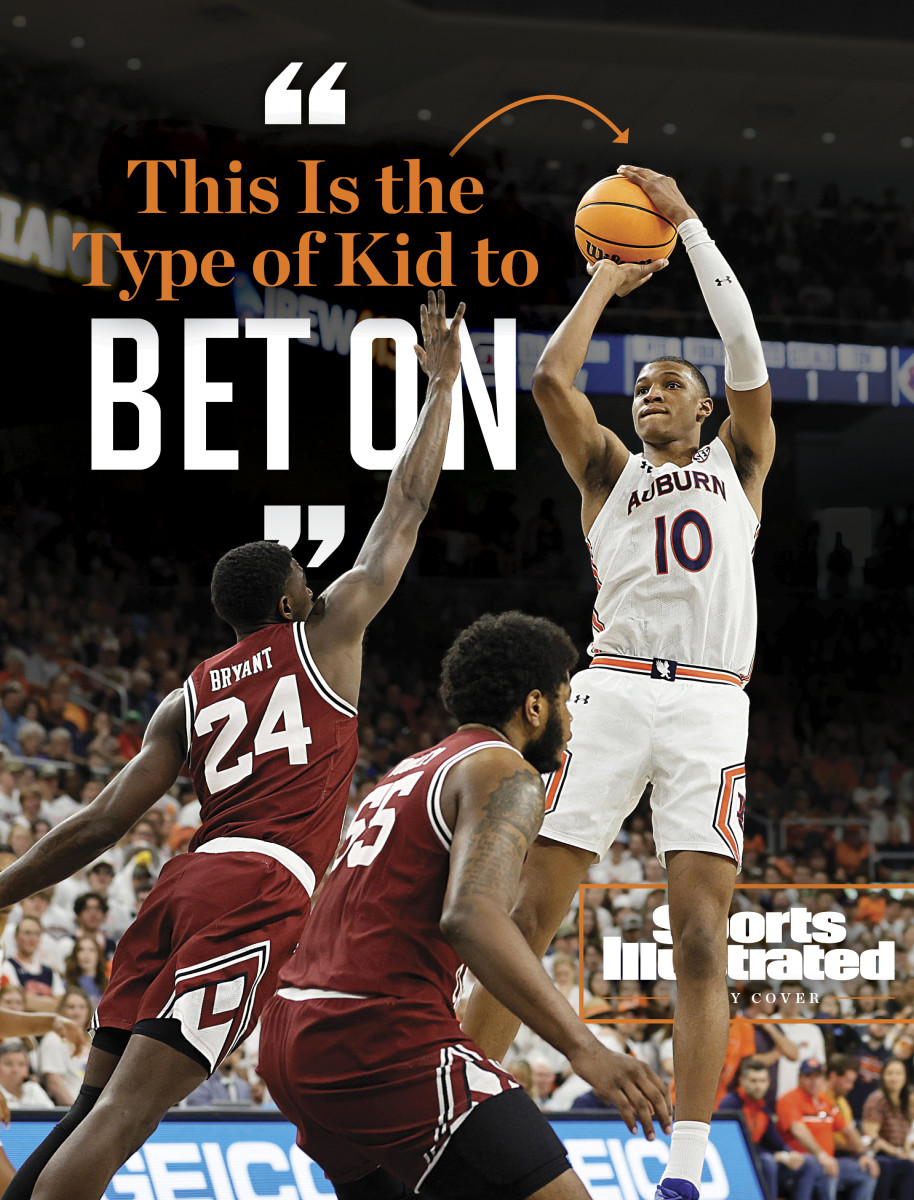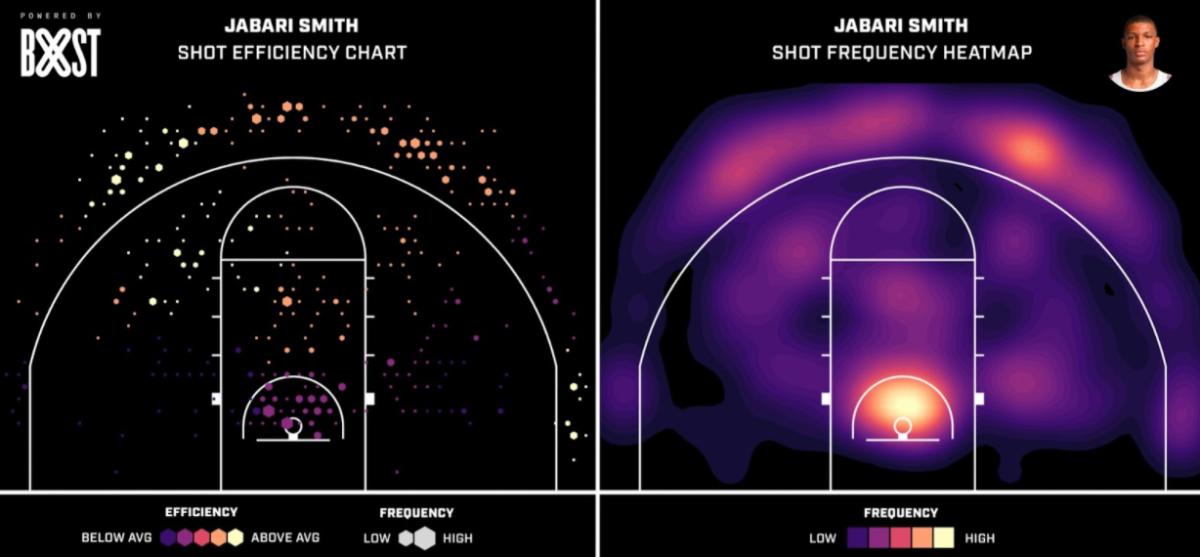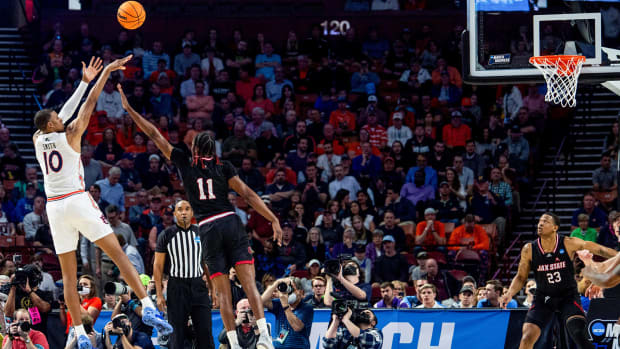The Case for Drafting Jabari Smith No. 1

It may say something about the 2022 draft class itself that the No. 1 selection has never widely been treated as a foregone conclusion. Over the course of the past year, four players have built legitimate cases and inspired debate and dissent in front offices around the NBA: Jabari Smith, Chet Holmgren, Paolo Banchero and Jaden Ivey.
While you can debate the merits of each prospect as a No. 1 pick contender in past draft classes, as the saying goes, teams can draft only what’s there. And at the end of the day, the fact there are four good options indicates palpable depth at the top of the draft. It wouldn’t be surprising whether any one of this quartet winds up having the best career in the class. The discourse has been healthy. But tomorrow night, someone is getting picked first. It should be Smith.

It probably hasn’t been emphasized quite enough how difficult it is to accomplish what Smith did as a true freshman: He finished the season averaging 16.9 points and 7.4 rebounds while shooting 42.9% from the field, 42% from three and 79.9% from the foul line. He hit the ground running, and Auburn went 28–6 and won the SEC’s regular-season title.
Smith played his entire season at 18 years old, making him six months younger than Banchero, an entire year younger than Holmgren and 15 months younger than Ivey. He was one of the most impactful players in college basketball, playing against good competition and in a team context that didn’t wholly favor him. And in some ways, his rise has still gone somewhat underappreciated, at least by typical top prospect standards.
When the season began, Smith’s candidacy at No. 1 wasn’t immediately clear, with that discussion centering on Banchero (SI’s preseason projected No. 1) and Holmgren, who memorably went head-to-head in Las Vegas right after Thanksgiving. But a few days before, Smith began to plant his flag with a 22-point performance in Auburn’s double-OT loss to Connecticut. He didn’t even shoot all that well in that game, but it was the competitive fire and maturity he showed while digging himself out of a frustrating first half—as an 18-year-old playing the biggest game of his season at that point—that captivated my imagination. The buttery jumper and the defensive tools required no nitpicking. It was obvious that Smith had a special mixture of skill set and approach. In the week that followed, the dialogue began to shift, and the rave reviews began to come in from NBA execs who’d already gone to see him.
Is Chet Holmgren the Future of Basketball?
Due primarily to the pandemic, I’d never had an extended opportunity to watch Smith before this season. That need had clearly become urgent, so I scheduled a trip to see him in Atlanta on Dec. 11. Watching him shoot around up close for the first time was convincing unto itself: His release point looked unblockable, his ball was unusually consistent, his mechanics were exceptionally quick and clean, and while his footwork needed some cleanup, he looked comfortable stepping into it off the dribble. Defensively, he was a menace. The game itself was kind of a dud, but Smith had 21 points, five rebounds and four assists in just 22 minutes in a 31-point blowout of Nebraska. He could make shots over people, he could hit them off-balance, he could shoot over contests and he didn’t have to do anything all that complicated to take over a game.
At that point, Banchero still felt like the popular No. 1 candidate, in the wake of his strong showing against Holmgren, but the discourse was shifting. “Jabari shoots it better, he’s a better defender, and those things are probably always going to be true,” one general manager in attendance remarked to me that day in Atlanta. It was a relatively simple argument. Smith took over the top spot on my draft board shortly afterward.
“He seems to have a surefire NBA-level skill in his shooting, and on top of that we’re talking about a guy who’s 6’10” doing that,” says one Western Conference scout. “A lot is made about the lack of creation, to which I’d say that seemed to stem at least partially, and most likely from, his lack of lower-body strength. He’s going to continue to develop. So this is a young freshman who was super productive and had an elite skill at 6’10” and is so moldable. And on top of that, when you do the intel, the background and the interviews it’s super high level. So this is the type of kid to bet on.”
At its root, modern NBA basketball is a constant battle for space, which breeds open shots. Offenses are designed to create and manipulate it, and defenses are working to erase it. Many of the league’s best players break convention and bend defenses with speed, strength, skill or all of the above. But most players still need to operate within the confines of the space they’re afforded, and the best ones find ways to put the ball in the basket when there’s a crowd.
Of the draft’s projected top three picks—at least, in my opinion—Smith’s ability to score over the top gives him the best chance to accomplish all those things at a high level. Because of the high likelihood that translates, much like Cade Cunningham last year, that makes him the most flexible potential centerpiece available when it comes to team-building. He fits alongside anybody.
While Smith may never have a ridiculous bag of dribble moves, he should realistically be able to manipulate, eradicate and generally dictate spacing on either end better than any of the draft’s top prospects. It can’t be emphasized enough that the threat of his shot is a massive separator: At the end of the day, we’re talking about someone who was a 91st percentile three-point shooter nationally, per analytics company Boost, while (again, for emphasis) playing his entire freshman year as an 18-year-old and shouldering a 91st percentile usage rate (27.4%). He’s already an NBA-caliber jump shooter, and defenses are never going to be able to help off him, making him an ideal player to pair with a creative guard. Even when Smith isn’t the focal point of plays—which he clearly can be—his presence will open up swaths of space for teammates to operate and give his team a safety valve if the ball rotates.
Thanks to our friends at Boost, here’s a look at Smith’s shot distribution from this season:

Smith’s chart certainly isn’t perfect—the midrange attempts are heavy, and his rim attempts are relatively infrequent—but his locational shot diversity does stand out. The Tigers made early exits in the conference and NCAA tournaments largely due to inconsistent guard play. Smith operated out of the midrange and against clogged paints quite a bit, with Auburn almost always deploying one of Walker Kessler and Dylan Cardwell at center. Most of those shots weren’t assisted. No other Auburn perimeter player was remotely as efficient a scorer, and Bruce Pearl intended to push Smith to his limits and give him room to grow, so Auburn lived with those shots. Their offense was designed for him to be an endpoint—a safety valve, even—not a conduit for playmaking. And he found ways to score from all over the floor despite his limitations.
While it’s entirely fair to nitpick Smith’s handle, which is functional but not dynamic, we also have to consider that—at least empirically speaking—he’s one of the most natural 6'10" jump shooters ever to enter the NBA at 19 years old. We shouldn’t expect him to turn into a Jayson Tatum–level off-dribble creator. But it’s pretty clear from his natural balance and comfort level taking difficult shots that a tough two for Smith is going to be a better shot than a tough two for most players. He’s the rare jump shooter who can turn a bad shot into a good shot, situationally speaking, because he’s mechanically so consistent, and his release is so high that most defenders can’t alter it. These are also shots that he practices constantly. Sometimes the notion of “shot creation” gets intrinsically associated with flashy handling, but when you shoot it as Smith does at his size, one or two dribbles can buy you more than enough space. He’s not going to bring the ball up the court, but it’s almost disingenuous to think he won’t improve. Playing in a creative offense with pass-first guards would go a long way to help him, too.

It’s also important not to conflate Smith’s 43% two-point percentage with the idea that he’s a bad finisher: He shot a perfectly respectable 61% at the rim, according to Boost, but attempted only 54 of those shots. The bigger issue here is rim frequency, but frankly, Auburn’s situation probably exacerbated his shot diet. The Tigers didn’t have reliable guard play and struggled to manufacture great looks for Smith at times. He was still their best late-clock option, but a lot of his shots were self-created from a standstill against set defenses as a result. It’s not hardwired into him that he has to take those all the time, but oftentimes, those were the best shots for his team. Smith is also clearly going to get stronger, particularly in his lower half and core, and should become more explosive and effective getting downhill. He flashed some sneaky explosiveness when he had room to take off toward the rim, and it’s a pretty good bet he’ll start to finish through bodies as he gets older. So, there’s certainly a glass-half-full way to interpret his shot diet.
“If I told you as a floor you were gonna draft a 6'10" kid who can move and shoot it above 40% from three, you’d say I’m all in,” says the Western Conference scout. “And I just think there’s a lot of evidence he’ll do that, plus a lot of other things and impact the game in other ways. Unicorn gets thrown around too frequently, but he’s just a freaky good prospect.”
Often buried in the whole dialogue about Smith’s offensive game was the fact that his defensive intensity was a constant positive throughout the season. Over the years, I’ve watched countless young players whose offensive success would dictate their effort on the other end. That’s not going to be a problem with Smith: On days when his shot didn’t fall, his commitment in other areas didn’t waver. He’s a very good defender whose body language frequently suggests that he actually likes defending. His ability to switch onto guards and move his feet allowed Auburn to trap aggressively on the perimeter when it wanted to. Smith has excellent balance and figures to be disruptive with his length and will be able to cover either forward spot at his size.
I also think there’s a pretty strong likelihood Smith winds up being able to play a little bit of center in the long run. While he doesn’t have a ton of length for his height, he’s a legitimate 6'10" in shoes, Auburn measured him with a 7'1" wingspan, and he excels at contesting around the rim without fouling, using his frame to contest vertically around the basket and forcing opponents to finish through his chest. He wasn’t tasked with a ton of rim protection because the Tigers parked Kessler at the rim all the time, but his technique and instincts are sound, and he knows how to use his size. Smith’s frame also has plenty of room to add muscle in his legs, core and upper body, and considering his feel for defending and covering ground, I think he’ll be able to moonlight at the five situationally. And hypothetically, deploying closing lineups around a switchable center who’s also a 40% three-point shooter and can hit shots from all over the floor sounds pretty nice.

The other big piece of the evaluation here is Smith’s potential to develop into a leader other players follow. This is all empirical, but I spent enough time on the ground with Auburn this season and making background calls for February’s daily cover story to feel pretty confident that Smith is cut from the right stuff to be a star. I’ll try to avoid the Pandora’s box of basketball clichés here, but it really does matter when you’re splitting hairs between elite prospects. Smith has always been young for his class. He was the only freshman on his team this year and he acclimated quickly, arriving in college with a willingness to be coached and no entitlement.
Smith is not only uncommonly driven for a person his age, but by all accounts, he’s been that way for most of his life. He’s meticulous, he’s a self-starter, he approaches tasks seriously and he’s poured himself into basketball. These are the types of habits that matter and are hard to fake. His father played in the NBA, but basketball was never forced onto him. And great things tend to happen when perfectionists fall in love with their chosen occupation on their own. When you watch Smith shoot around, notice the immaculate mechanics and see that every shot comes out of his hand exactly the same, it’s not just a manifestation of unusual athleticism and coordination. You don’t perfect a skill that most players twice your age have never mastered without an exceptional approach to doing the work. And it’s those intangibles, coupled with the fact he could be a generational shooter, that would make Smith a legit No. 1 pick contender in most drafts.
If the elements of the argument sound too good to be true, that’s kind of the point. Smith is going to shoot, he’s going to defend, he’s going to keep getting better and he’s more than likely going to be someone who sets the tone. This is a pretty good draft at the top. Holmgren, Banchero and Ivey all have All-Star potential. All four prospects have their flaws. But it’s Smith who offers the simplest pathway to creating a winning environment, whose elite skills should translate the easiest and who offers a team the most optionality in building a roster moving forward. Don’t overthink this.
More SI Daily Cover Stories:
• Is Chet Holmgren the Future of Basketball?
• Armando Bacot Is Following the Money
• Should Russian Athletes Be Allowed to Compete?
